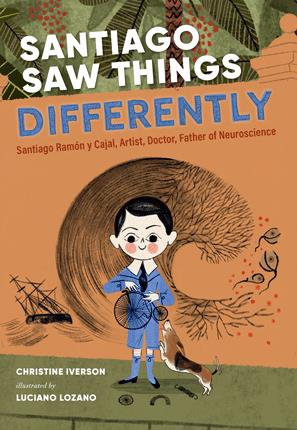| Santiago saw things differently : Santiago Ramon y Cajal, artist, doctor, father of neuroscience Author: Iverson, Christine | ||
| Price: $23.78 | ||
Summary:
Santiago Ramon y Cajal's father, the village doctor, wants Santiago to be a doctor. He discourages his willful son's love and aptitude for art. But drawing and painting are as necessary to Santiago as breathing, so when his father confiscates his art supplies, the boy finds a way to draw in secret. He draws on doors, gates, and walls, and to the neighbors, his drawings are a nuisance. Art helps him discover what no one else could--branching connections within the nervous system.
| Illustrator: | Lozano, Luciano |
Reviews:
Kirkus Reviews (09/15/23)
School Library Journal (+) (03/29/24)
Booklist (09/01/23)
Full Text Reviews:
Booklist - 09/01/2023 As a child, Santiago expressed himself through art, using charcoal and chalk to draw pictures on doors and walls in his Spanish village. His father, a doctor, expected Santiago to set his artistic ambitions aside and study medicine. But as the narrative emphasizes, “Santiago saw things differently.” While following the educational path demanded by his father, he found ways of making it his own. He saw beauty inside the human body and became an anatomy professor in 1883. Looking through a microscope, he drew pictures showing that neurons (previously considered a tangled web) are individual cells with treelike forms and observable stages of growth. His drawings and conclusions provided the basis of neuroscience. Iverson credits the man’s early artistic inclination for his accomplishments as a scientist whose observations led to logical conclusions. Reproductions of Ramón y Cajal’s drawings appear on relevant pages of the book, alongside Lozano’s handsome digital illustrations, which feature expressive line drawings brightened with solid colors and occasional patterns. A picture book showing the value of the A in the STEAM field. - Copyright 2023 Booklist.
School Library Journal - 03/29/2024 Gr 1–3—In the mountains of Spain, in his grandfather's shop, Santiago Ramón y Cajal as a boy didn't see dust motes flying into the breeze, but elements that "sparkled and soared in a kaleidoscope of motion." Determining that their son and his insistence on drawing everything at every moment did not have art in his future, his parents directed him to a study of medicine. For readers expecting this stubborn, talented person to break free of this directive, a plot twist: the boy went on to study the fibers and paths of the brain and became the founder of neuroscience. Through his drawings, he found the patterns and structures that made it possible for others to heal brains. He won the Nobel Prize for this work, sharing the stage with another who openly disparaged and remained skeptical of his work. Ramón y Cajal not only saw things differently, but he allowed others to see, too, and changed the course of medicine. The illustrations are almost naïve at first, in the straight lines and round heads of children's cartoon characters. In a muted palette of slate blues and goldenrod, with bursts of salmon and mint green, the artwork gives way to a more realistic, natural look that conveys a sense of history. And then, with the overlay of Ramón y Cajal's own work, the contrast is splendid. The drawings of cells, neural paths, and fibers are perfect to pore over. Author's note and references consulted are included in the back matter. VERDICT Whether for the art shelves or the science collection, this biography cannot go deep, but it covers the surface events of Santiago Ramón y Cajal's journey in a way that is breathtaking, unbelievable, and inspiring.—Kimberly Olson Fakih - Copyright 2024 Publishers Weekly, Library Journal and/or School Library Journal used with permission.



